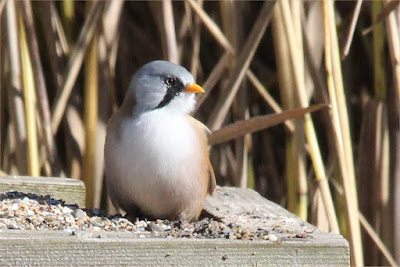 |
| Bearded tit |
It was still a very foggy morning when I set off for Leighton Moss. Had I known it would turn into a bright Summer's day with a twitchable wader and a school party I might have made other plans. Just as well I didn't know: it was a nice day, the birdwatching was stress-free and productive and the kids were brilliant, much better behaved than most grown-ups.
As the train passed the coastal hides I was struck by how bone dry the pools were. The only water was on the pool by the Allen Hide, hosting a few black-headed gulls and a sleeping spoonbill doing an excellent impersonation of a mattress on a stick.
The school party was in the picnic area watching the birds on the feeders so I went straight to Lilian's Hide to see if the pectoral sandpiper that had been reported was still there.
The first things I noticed were the couple of hundred roosting black-tailed godwits and a couple of great white egrets. Every so often the egrets would get too close to each other and they'd indulge in a bit of aggressive display, pointing their beaks skywards and strutting about in an exaggerated manner.
 |
| Great white egret and black-tailed godwits |
 |
| Life imitates art: teal and plastic decoy tern |
 |
| Pectoral sandpiper (heavily cropped record shot) |
A chap helpfully pointed out where to find the pectoral sandpiper. It was well away from everything else, the only bird on a stretch of mud in a little inlet, so it was dead easy to spot. Unfortunately, the strong backlighting and reflections from the mud made it a largely unidentifiable silhouette. I had a stroke of luck when it moved behind a small puddle and the reflected light lit up its underside, showing the sharp distinction between the brown breast and white abdomen. I looked away for a moment, came back and found I'd lost the bird. All that could be seen was a stone in the middle of the mud. After a couple of minutes the stone got up and started wandering around again.
 |
| Heron and black-tailed godwits |
 |
| Great white egret and black-tailed godwits |
There were plenty of teal loafing round the margins of the pool and a dozen gadwall lingered in the deep corner of the pool in the company of a few coots and a dabchick. And I noticed a couple of knots in amongst the godwits.
I'd been shown where to find the pectoral sandpiper so I paid the favour on by spending five minutes helping newcomers find it.
There were a couple of mixed tit flocks in the trees along the path into the reeds. Mostly blue tits and great tits with long-tailed tits and chiffchaffs along for the ride.
 |
| From the Tim Jackson Hide |
The pools in front of the Tim Jackson Hide were lower than usual but plenty enough for a small flock of gadwall and half a dozen moorhens. And plenty enough for hordes of dragonflies, mostly unidentifiable in the strong light. A few brown hawkers were easy enough to get by their size and russet glint in the sunlight. As far as I could tell, most of the rest were common hawkers and common darters, with a couple of migratory hawkers making up the numbers.
As I walked down to the Griesdale Hide I came across a group of people taking photos by one of the grit trays. A male bearded tit was ignoring its audience and getting on with the business of topping up on grit. I was quite surprised, it was late lunchtime and my general experience is that you don't see them on the grit trays after 11:00am. A bonny looking bird.
 |
| Bearded tit |
The pools at the Griesdale Hide were bone dry though a heron managed to find an eel passing along one of the little ditches by the reeds.
 |
| From the Griesdale Hide |
Walking back I found a couple of willow warblers calling from willows in the reedbed and a juvenile chiffchaff assayed a bit of song from the trees at the corner of the reserve. There was another mixed tit flock, this one with more long-tailed tits, and a treecreeper rummaged around in the depths of the dry stone wall by the field. A buzzard soaring high on the thermals was joined by a noisy pair drifting over from the coastal marsh.

No comments:
Post a Comment